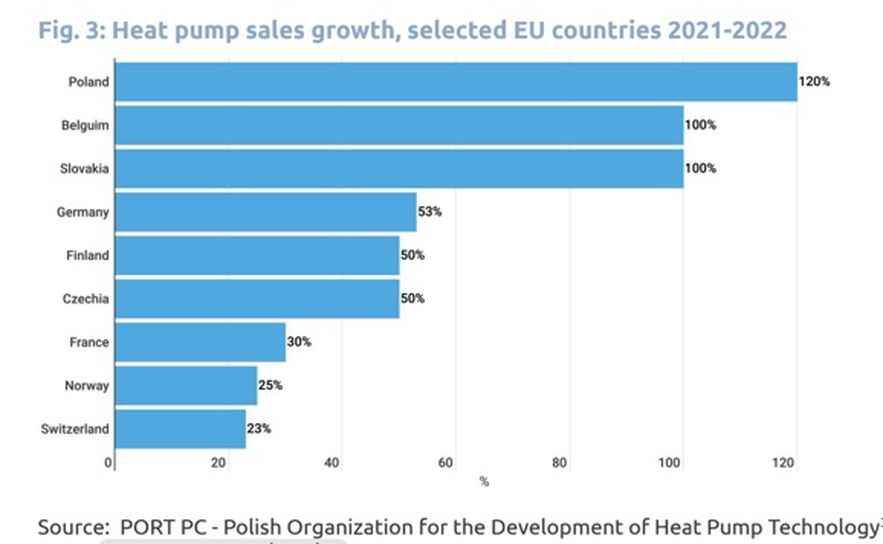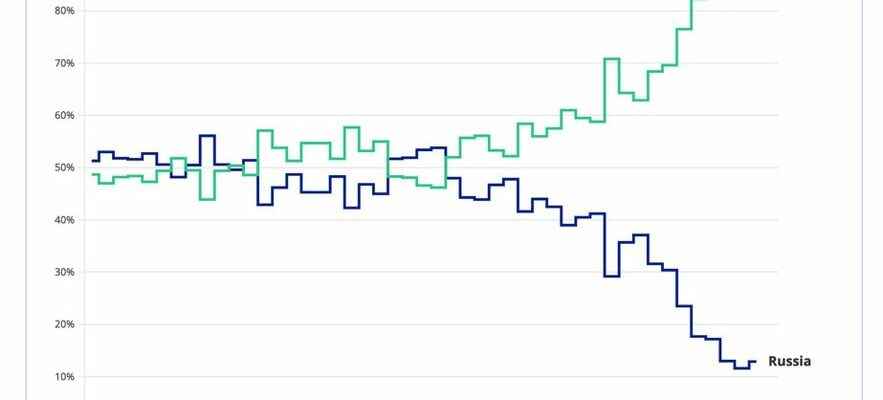Several decades will undoubtedly be necessary to estimate the impact of the war in Ukraine, warns Fatih Birol, executive director of the International Energy Agency (IEA). But over a period of twelve months, the shock wave suffered by the economy and households is already spectacular. In a note published on February 24, Zero Carbon Analytics, a group of researchers specializing in climate change and energy transition, discusses this new global energy landscape in detail.
From shortage to overcapacity
This is one of the most spectacular shifts of this crisis. A year ago, Russia still accounted for half of Europe’s gas supplies. In a few months, its share fell to around 10%. The United States, Norway and Algeria have notably taken over. But following the Russian invasion of Ukraine, European countries also boosted their production capacities by reactivating “dormant” installations while developing new projects.
Share of Russia in European gas
© / European Commission
Thus, according to data compiled by the International Group of Liquefied Natural Gas Importers (GIIGNL), European capacities will increase by 30% between 2021 and 2024. “New projects can be developed quickly by chartering floating units and building pipelines to transport natural gas to existing networks on land,” said a note from the US Energy Information Agency. Europe is adapting so quickly that it is even beginning to worry some specialists. According to the latest figures, the new terminals represent, in volume, 165% of what Russia supplied in November 2022. The risk? Generate overcapacity. “The Zero Carbon Waste note alerts us to the fact that the growth of EU LNG infrastructure could lead to excess supply by next year. This could have disastrous consequences, either by derailing the Europe’s climate ambitions, or by developing non-profitable activities afterwards”, worries Angela Picciariello, Senior Researcher at the International Institute for Sustainable Development.
External accounts in the red
The EU has certainly managed to replace almost three quarters of its Russian gas imports, but at what cost. The frantic search for alternatives has been accompanied by a very strong increase in its imports. During the first nine months of 2022, the Old Continent spent 252 billion euros on gas imports, an increase of 186 billion euros compared to the same period of the previous year (+286%)! Reflecting this trend, France’s trade deficit reached a record level: 164 billion euros in 2022. could not be made during the pandemic, and because we also have an energy price on the markets which has doubled”, pleads Olivier Becht, Minister Delegate in charge of Foreign Trade, Attractiveness and the French of According to him, this cyclical part of the deficit will erase itself.Not enough to return to equilibrium, however, because there will remain the structural part, linked to the deindustrialization observed over the past 25 years.
Impoverished households
It is an XXL shock absorber put in place by European governments: since September 2021, they have committed 768 billion euros to protect consumers from high energy prices. But this only partially offsets the direct and indirect effects of this increase. Proof, in France, the Food purchases have declined over the past seven months. Experts from the University of Cambridge have looked at the impoverishment suffered by households. This would reach for the year 2022, 410 euros in France, 550 in Spain, 735 in Germany, 914 in Poland and 1400 in Italy. INSEE also mentions losses of several hundred euros. Direct and indirect energy-related costs incurred by households have increased by 62 to 112%, completes a Nature article by researchers at the University of Groningen in the Netherlands. Result: between 78 and 141 million additional people will potentially be pushed into extreme poverty.
Positive effects on the ecological transition
Despite the gas rush and the restarting of coal-fired power stations in Germany, Europe has not lost sight of its objectives in the fight against global warming. A few figures show it:

Heat pump sales growth
© / Polish Organization for the Development of Heat Pump Technology
In 2022, wind and solar generated 22% of EU electricity, a record. For the first time, the gas (20%) is exceeded. According to an analysis by the think tank Ember, fossil fuel production could fall by 20% in 2023. Another encouraging change is that sales of heat pumps are exploding almost everywhere. Over one year, they increased by 120% in Poland, and by 100% in Belgium and Slovakia. In France, the increase reached 30%.
